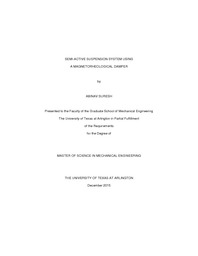
ATTENTION: The works hosted here are being migrated to a new repository that will consolidate resources, improve discoverability, and better show UTA's research impact on the global community. We will update authors as the migration progresses. Please see MavMatrix for more information.
Show simple item record
| dc.contributor.author | Suresh, Abinav | |
| dc.date.accessioned | 2016-02-24T20:24:06Z | |
| dc.date.available | 2016-02-24T20:24:06Z | |
| dc.date.issued | 2015 | |
| dc.date.submitted | January 2015 | |
| dc.identifier.other | DISS-13381 | |
| dc.identifier.uri | http://hdl.handle.net/10106/25605 | |
| dc.description.abstract | Magnetorheological (MR) Fluid changes its yield strength when it is subjected to a magnetic field. When this fluid is used inside a damper, it has the ability to change the damping coefficients when it is acted upon by magnetic fields. In this experiment, a MR damper was tested on a shock dyno, where characteristics of the damper was found. Three parameters were changed during the course of the experiment, namely: electric current supplied through the solenoid of the damper, displacement amplitude of the piston and driving frequency of the motor. The results show that there was an increase in damping force when the three parameters were increased. Since the damper cannot be categorized as hard or soft using damping force, the damper and its configuration were represented in the terms of energy dissipated and equivalent damping coefficient. The trends of energy dissipated and equivalent damping coefficients were also compared with the change in electric current, displacement amplitude and driving frequency. Using the above results, a mathematical model was developed to predict the behavior of the MR damper. This model can be used in a control system, where a specific damping force and damping ratio is desired.A ‘Single Degree of Freedom’ (SDOF) system with a mass connected to a spring and a MR damper was studied. The response of the system was analyzed in the terms of transmissibility and phase angle. The results obtained were found similar to a passive suspension system with different damping ratios.A quarter car model was studied using the MR damper. A step input was chosen as road excitation and the responses of sprung and unsprung masses were studied. Sky-hook control strategy was utilized in the model to demonstrate the benefits of continuously changing the damping ratio in the system. | |
| dc.description.sponsorship | Woods, Robert L. | |
| dc.language.iso | en | |
| dc.publisher | Mechanical Engineering | |
| dc.title | Semi-active Suspension System Using A Magnetorheological Damper | |
| dc.type | M.S. | |
| dc.contributor.committeeChair | Woods, Robert L. | |
| dc.degree.department | Mechanical Engineering | |
| dc.degree.discipline | Mechanical Engineering | |
| dc.degree.grantor | University of Texas at Arlington | |
| dc.degree.level | masters | |
| dc.degree.name | M.S. | |
Files in this item
- Name:
- Suresh_uta_2502M_13381.pdf
- Size:
- 2.057Mb
- Format:
- PDF
This item appears in the following Collection(s)
Show simple item record


